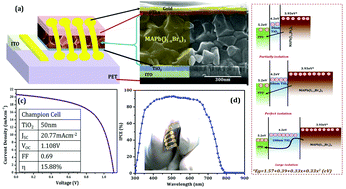Efficient planar n-i-p type heterojunction flexible perovskite solar cells with sputtered TiO2 electron transporting layers†
Abstract
The development of hybrid organo-lead trihalide perovskite solar cells (PSCs) comprising an electron transporting layer (ETL), a perovskite light absorber and a hole transporting layer (HTL) has received significant attention for their potential in efficient PSCs. However, the preparation of a compact and uniform ETL and the formation of a uniform light absorber layer suffer from a high temperature processing treatment and the formation of unwanted perovskite islands, respectively. A low temperature/room temperature processed ETL is one of the best options for the fabrication of flexible PSCs. In the present work, we report the implementation of a room temperature processed compact TiO2 ETL and the synthesis of extremely uniform flexible planar PSCs based on methylammonium lead mixed halides MAPb(I1−xBrx)3 (x = 0.1) via RF-magnetron sputtering and a toluene dripping treatment, respectively. The compact TiO2 ETLs with different thicknesses (30 to 100 nm) were directly deposited on a flexible PET coated ITO substrate by varying the RF-sputtering time and used for the fabrication of flexible PSCs. The photovoltaic properties revealed that flexible PSC performance is strongly dependent on the TiO2 ETL thickness. The open circuit voltage (VOC) and fill factor (FF) are directly proportional to the TiO2 ETL thickness while the 50 nm thick TiO2 ETL shows the highest current density (JSC) of 20.77 mA cm−2. Our controlled results reveal that the room temperature RF-magnetron sputtered 50 nm-thick TiO2 ETL photoelectrode exhibits a power conversion efficiency (PCE) in excess of 15%. The use of room temperature synthesis of the compact TiO2 ETL by RF magnetron sputtering results in an enhancement of the device performance for cells prepared on flexible substrates. The champion flexible planar PSC based on this architecture exhibited a promising power conversion efficiency as high as 15.88%, featuring a high FF of 0.69 and VOC of 1.108 V with a negligible hysteresis under AM 1.5 G illumination. Furthermore, the mechanical bending stability revealed that the fabricated devices show stable PCE up to 200 bending cycles. The interface properties revealed that the 50 nm thick TiO2 ETL provides superior charge injection characteristics and low internal resistance. The present work provides a simplistic and reliable approach for the fabrication of highly efficient stable flexible perovskite solar cells.


 Please wait while we load your content...
Please wait while we load your content...